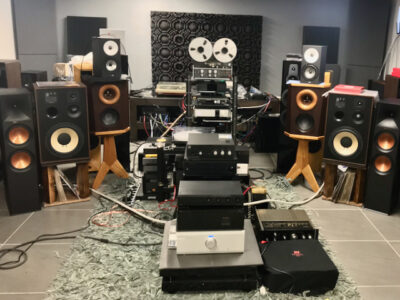
Understanding Audiophile Cables
Audiophile cables, at their core, serve the fundamental purpose of transmitting electrical signals from one audio component to another, be it from a source device like a CD player or a DAC (Digital-to-Analog Converter) to an amplifier, or from an amplifier to speakers. However, for enthusiasts of high-fidelity audio, these cables are not just conduits; they are conduits that must preserve the purity of sound, minimise interference, and faithfully reproduce every sonic detail.
Types of Audiophile Cables
- RCA Cables: RCA (Radio Corporation of America) cables are ubiquitous in the world of audio connections. They are commonly used for analog audio signals, such as those between CD players, turntables, preamplifiers, and amplifiers. The design and quality of RCA cables can significantly impact sound reproduction, with factors like cable material, connector construction, and shielding influencing signal integrity. Speaker wires
- XLR Cables: XLR (External Line Return) cables are known for their balanced connections, which help reduce noise and interference. They are often used in professional audio setups and high-end audio systems. XLR cables feature three pins for carrying balanced signals, with separate conductors for positive, negative, and ground, ensuring superior noise rejection and pristine audio transmission.
- Speaker Cables: Speaker cables carry amplified electrical signals from amplifiers to loudspeakers. While some argue that exotic materials and designs make a difference in sound quality, others prioritize factors like gauge and impedance matching. High-quality speaker cables are characterised by low resistance, adequate gauge size to handle power demands, and proper insulation to prevent signal loss or distortion.
- Digital Cables: Digital cables, such as Optical (Toslink) and Coaxial cables, transmit digital audio signals between devices like CD players, DVD players, and AV receivers. They are crucial for maintaining signal integrity in digital audio transmission. Digital audiophiles often seek cables with superior construction, high-quality connectors, and advanced shielding to minimize jitter and ensure accurate data transfer.
- USB Cables: USB cables are essential for connecting digital audio sources, such as computers or mobile devices, to DACs or audio interfaces. Like other digital cables, the quality of USB cables can influence the fidelity of audio playback. Audiophile-grade USB cables often feature improved shielding, high-purity conductors, and enhanced connectors to minimize noise and maximize signal transfer.
- Ethernet Cables: In networked audio setups, Ethernet cables carry audio data between devices, such as network streamers and music servers. While standard Ethernet cables suffice for many applications, audiophiles often seek higher-quality cables for improved performance. Factors like cable construction, conductor material, and shielding can affect the stability and fidelity of audio streaming over Ethernet networks.
- Power Cables: Power cables supply electricity to audio components, and some audiophiles believe that high-quality power cables can reduce noise and improve the overall sound quality of audio systems. While the impact of power cables on audio performance is debated, factors like conductor material, insulation quality, and connector design can influence power delivery and mitigate electromagnetic interference.
- Interconnect Cables: Interconnect cables refer to any cables used to connect audio components together, including RCA, XLR, and digital cables. These cables play a crucial role in maintaining signal integrity and minimizing interference. Audiophile-grade interconnect cables often feature advanced construction techniques, premium materials, and precision engineering to ensure optimal audio transmission and fidelity.
- HDMI Cables: HDMI (High-Definition Multimedia Interface) cables are commonly used to transmit high-definition audio and video signals between devices such as Blu-ray players, gaming consoles, and AV receivers. While HDMI cables are primarily associated with video, they also carry audio signals, making them essential for home theater and multimedia setups. Some audiophiles prefer high-quality HDMI cables with features like gold-plated connectors and advanced shielding to ensure optimal signal transmission and minimize interference, thus enhancing the audiovisual experience.
Debunking Myths and Realities
Audiophile cables have long been a subject of debate, with proponents extolling their virtues and skeptics dismissing them as snake oil. While it’s true that not all claims about audiophile cables hold water, there are some tangible factors to consider:
- Material Quality: The materials used in cables, such as copper, silver, and gold, can impact conductivity and signal transmission. However, the extent to which these materials affect sound quality is subject to debate.
- Build Quality: Well-constructed cables with proper shielding and insulation can help minimize interference and noise, resulting in cleaner audio signals.
- System Synergy: The impact of cables on sound quality can vary depending on the rest of the audio system. What works well in one system may not yield the same results in another.
- Subjectivity: Ultimately, the perception of sound quality is highly subjective. What one listener perceives as an improvement in sound may be negligible to another.
Conclusion:
In the world of audiophilia, where passion meets precision, the choice of cables is a deeply personal decision. While audiophile cables may not possess magical properties capable of transforming mediocre audio systems into sonic marvels, they can play a role in fine-tuning and optimizing the listening experience for discerning enthusiasts.
Whether you’re an ardent believer in the transformative power of audiophile cables or a skeptic cautious of their claims, one thing remains clear: the pursuit of sonic excellence knows no bounds, and audiophile cables are but one facet of that endless quest.
In the end, perhaps it’s not just about the cables themselves, but the joy of exploring, experimenting, and discovering the nuances that make the world of high-fidelity audio so endlessly fascinating. And, as you embark on your sonic journey, may your cables be true, signals pure, and your music transcendent.
- Author: Tomas Blinder
- Dated: 03/04/2024
Perkune I professional audio service